Is Mexico City getting too cool for its own good? I returned to find out
16 min readMEXICO CITY —
From the first day I set foot here, I always knew I wanted to live in the Centro Histórico. It was overwhelming. The constant drumming, sirens, marches, music and street vendors. The clopping of hooves of the police horses. The smell of roasting coffee or corn. Shouting, chants, wails, intimations of ghosts. Al pastor meat sizzling. Raw chickens for sale. Mosquitoes. Rain.
This was downtown Mexico City to me when I stayed here for the summer of 2002, part of a small wave — more like a trickle — of adventure-seeking foreigners finding their way. Most of the other young Americans and Europeans I met living and working in the city at the time regarded me neutrally, an English-speaking curiosity, a sort of errant Mexican from the north.
I think we were all drawn to the same fire, though. It was the city itself, frenzied and spontaneous in every way, with three intensely threaded civilizations layered upon one another: imperial Indigenous, colonial Spanish and then globalizing and chaotic modernity.
Parents warned you to “never go there.” For decades, it was the “biggest city in the world” and an ultra-urban case study for excessive pollution and crime.
Sounded fun, I thought.
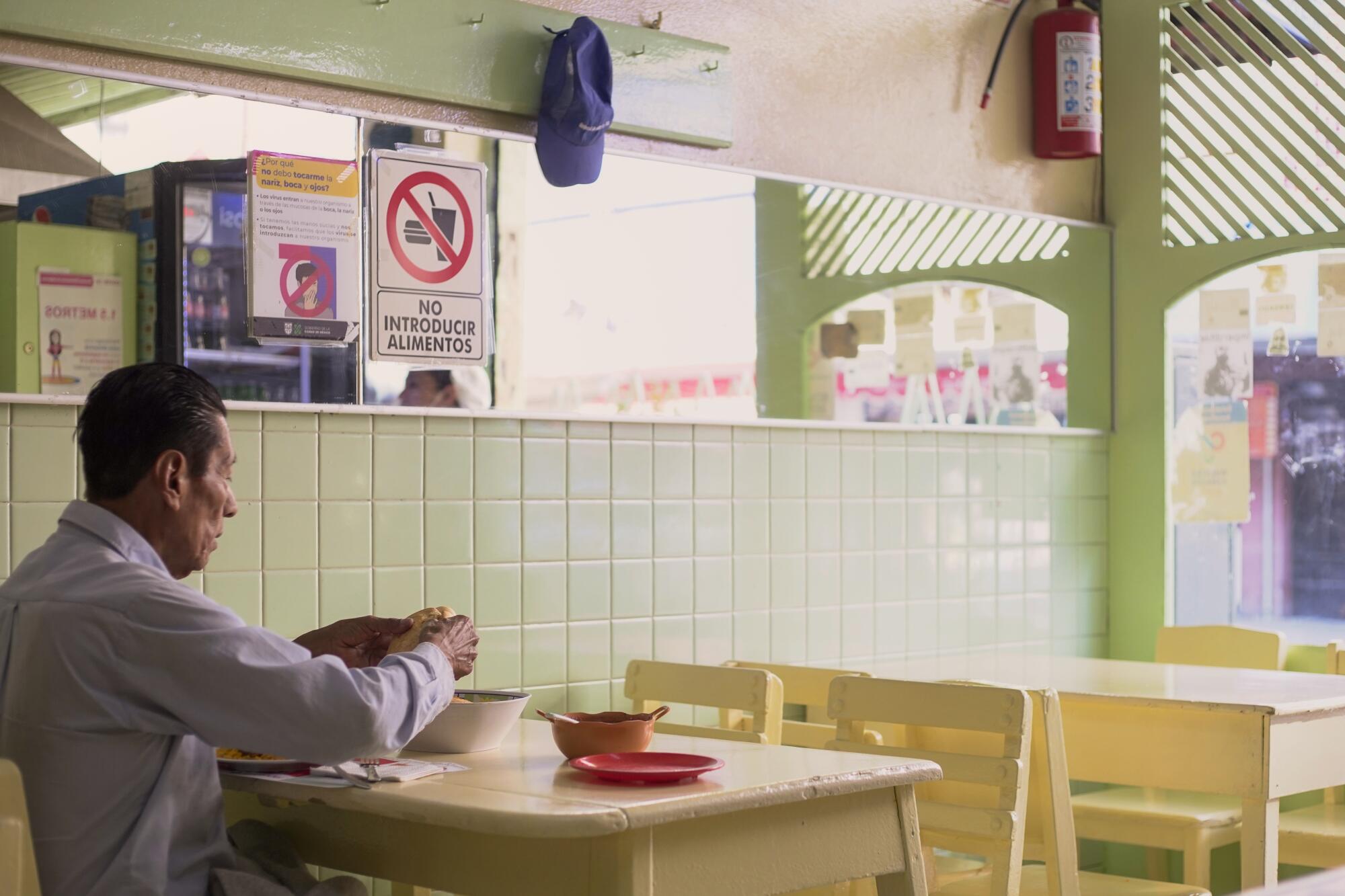
Mi Fonda is its official name, but everyone in the neighborhood calls it La Paella Valenciana, a classic diner serving Mexican-style paella.
(Eunice Adorno / For The Times)
Before social media, and before the eventual tourism campaigns, Mexico City was an elusive gem. Most of the young people I knew entering adulthood at the same time had their sights set on New York, Paris or London. But if you knew, you knew, and I had an inkling that, compared to its cohort global cities, the extravagance of Mexico City’s dining and party culture could surpass them all.
Later on, I would move into the downtown neighborhood of Colonia Centro, for good. The city was not trendy. Twenty years ago, all of it felt like it was just buoyed out at sea somewhere, like a port with no ocean. Cast off.
Maybe I’d return to the United States one day, I told myself, or maybe I wouldn’t.
In 2007, I relocated indefinitely and found my first solo apartment downtown the next year. Eventually I would return to the States, but I still visit my close friends in Mexico City at least once a year. Things are different now. You often hear someone in a social setting in L.A. hyperbolically proclaim Mexico City the best in the world for eating “right now,” and how it is “so cheap.” Consequently, there is gentrification talk.
Since the COVID-19 pandemic, so-called digital nomads have been flocking to Mexico’s capital to enjoy its quality of life, affordability and a range of cuisines and culinary customs. Housing displacement concerns are growing, and there are now rumblings of a backlash to foreigners, who are accused of pushing up rental prices and gobbling up properties.
Even downtown has residents worried. Earlier this year, the last tenants of an iconic Art Deco building in Colonia Centro were displaced, reportedly so that the building could be renovated and flipped into a hub of short-term rental units aimed at tourists.
This building, the Edificio Victoria on Calle López, is also my former home.
For years, I resisted the concept of gentrification, as we know it in the U.S., occurring in Mexico City, because to me the discourse itself seemed like a reflection of the colonial gaze. Roughly half the population of Mexico still lives in poverty, so making loose comparisons between Mexico City and places in the developed world (“It’s the new Berlin”) is disingenuous to socioeconomic realities. But the news about Edificio Victoria was alarming. Could downtown Mexico City, gulp, truly be gentrifying?
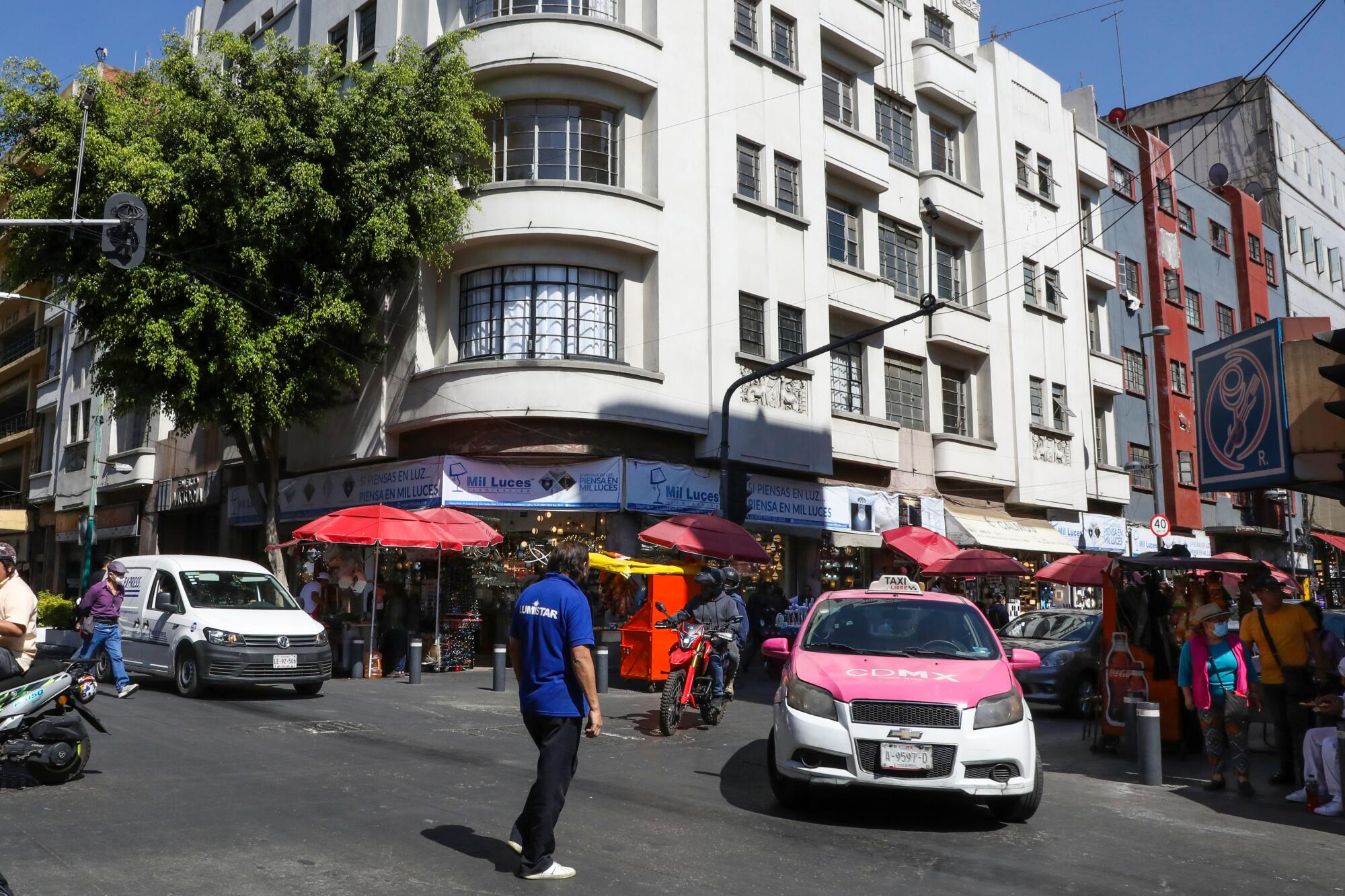
Edificio Victoria at Calle López 44 is an iconic example of the Mexican Art Deco movement. The writer lived in units 106 and 205.
(Eunice Adorno / For The Times)
I was a California border kid with Mexican roots but not a lot of understanding of my ancestral country beyond Baja California. I had to go down to Mexico to find out what being from this place by lineage could actually mean to me.
The Centro specifically was the most distilled version of what I was after: full and total immersion. It seemed like all of Mexico’s secrets were crammed right here, a few square miles that have been intensely urbanized since the 1300s. Most of the city we know today was a craggy and depleted lake bed for centuries, but these buzzing streets have always been like this: kinetic.
Probably most of the best food was in the Centro Histórico as well.
I dived in, stomach first. Everything was different, even the beans. I grew up eating refried brown pinto beans, not the black beans common in central and southern Mexico. Here, I ate pre-Hispanic dishes that were totally new to me, from the simple to the baroque, from the pleasurable to the exceedingly spicy.
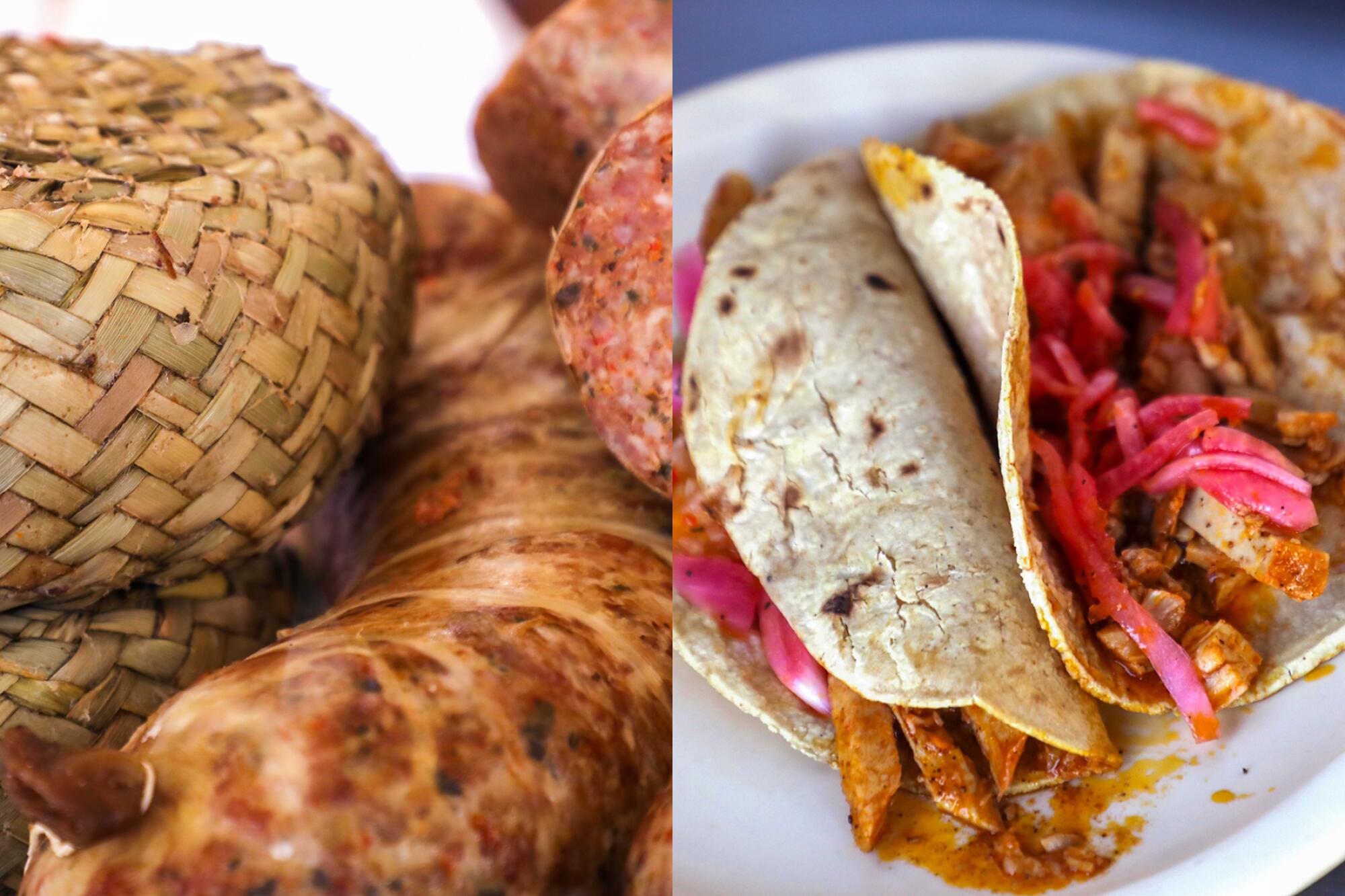
Reed-wrapped head cheese and obispo at Ricos Tacos Toluca, left, and tacos de cochinita pibil at El Taco de Oro, on Calle López.
(Eunice Adorno / For The Times)
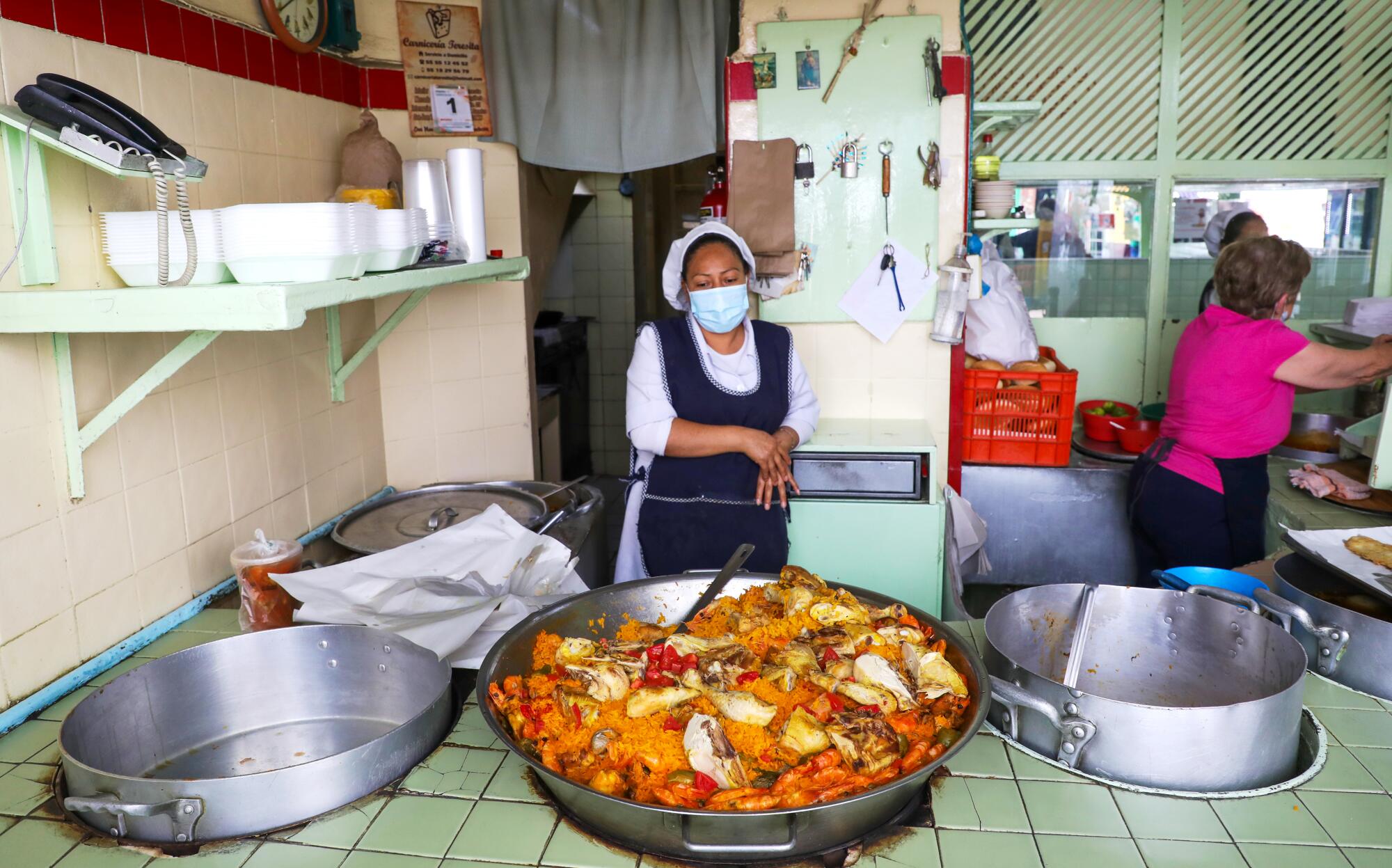
La Paella Valenciana has been serving the same paella since the 1950s, orange-hued saffron rice adorned with large shrimp, mussels and chicken breast, coddled gently all day over low heat.
(Eunice Adorno / For The Times)
I had my first blue corn tlacoyo from an Indigenous vendor sitting near the Zócalo, my first cantina crawl on Calle Bolivar and my first plate of Mexican paella valenciana on Calle López. There were tacos galore, meats and sides I simply didn’t grow up with and then couldn’t stop eating and drinking: tongue, suadero, cheek, candied guayabas, milk curds with sweet bread, fries on tacos, gummy candy in beer, mezcal from Durango and Guerrero.
I learned that “quesadilla” didn’t necessarily mean “with cheese,” and that you needed to specify if you wanted cheese with the actual quesadilla filling: Favorites include the darkened corn fungus huitlacoche, squash blossoms, chicken tinga and chicharrón bits mixed with cooked potatoes.
I embraced crickets roasted in garlic, green chorizo, street churros, head cheese and ears of corn grilled over mesquite, slathered with tangy mayonnaise and doused with chile powder and crumbly cheese for a snack to devour while walking. The day I tried the ancient fermented aguamiel of pulque, I knew I’d never be the same again.
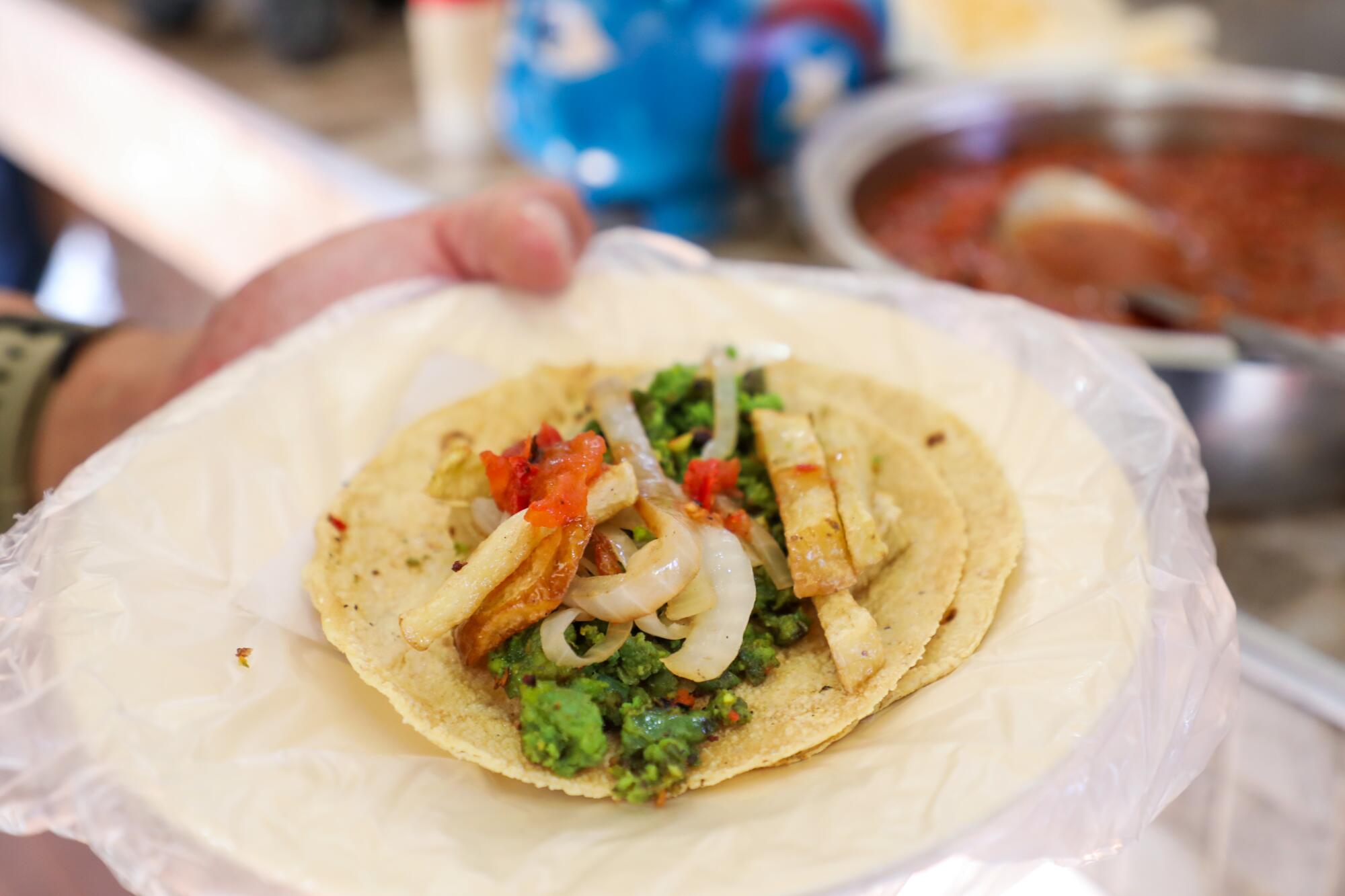
A taco of green chorizo and fries, with grilled onions and red salsa, from Ricos Tacos Toluca. The family of taqueros treks in daily from the Toluca metropolitan region with their classic embutidos, or sausages.
(Eunice Adorno / For The Times)
Lunch was a parade. I learned to admire the gentility of a wide-rimmed soup bowl filled to the very edge of the lip with fragrant chicken consomé, the first dish you are traditionally offered in a fonda. How about one whole tilapia fish dumped in the fryer and served with rice and beans? Or maybe the dish of buttery chilled avocado slices, filled with scoops of tuna salad and adorned with discs of raw tomato and onion for a hearty but cooling lunch?
Dessert was included, a little flourish, like a jiggling rectangle of bright green gelatina, or simply a wrapped mini candy bar, to munch on the way back to work. So much of eating culture, I learned, centered on the concept of “just because.” Everything seemed to taste better than the thing before — even the street hamburgers.
Wandering near López and Victoria streets in spring 2008, I noticed an Art Deco building with a regal if gloomy façade. It looked achingly symmetrical, as if carved from a single piece of stone. Juliet balconies wrapped around the building’s corner. Clearly, its designer had glorious ambitions for life there, giving it pyramidal cupolas at the penthouse level and relief sculptures of xoloescuincle dogs and agaves wedged into the battered exterior. It looked to be built in the 1930s or 1940s.
“Edificio Victoria,” the metal Art Deco letters said over the door. A few were missing, but their shadows of rust remained, legible ghosts.
I peered through the glass on the heavy metal door and saw a wine-colored marbled lobby with pillars and smooth benches. Eventually, a manager allowed me to see an open unit. It was a studio-style flat, with shiny wooden floors, Art Deco moldings on the ceiling, a workshop room facing rowdy Calle Victoria and a nook for a bed.
The unit was available for 2,800 pesos a month. I said I’d take it.
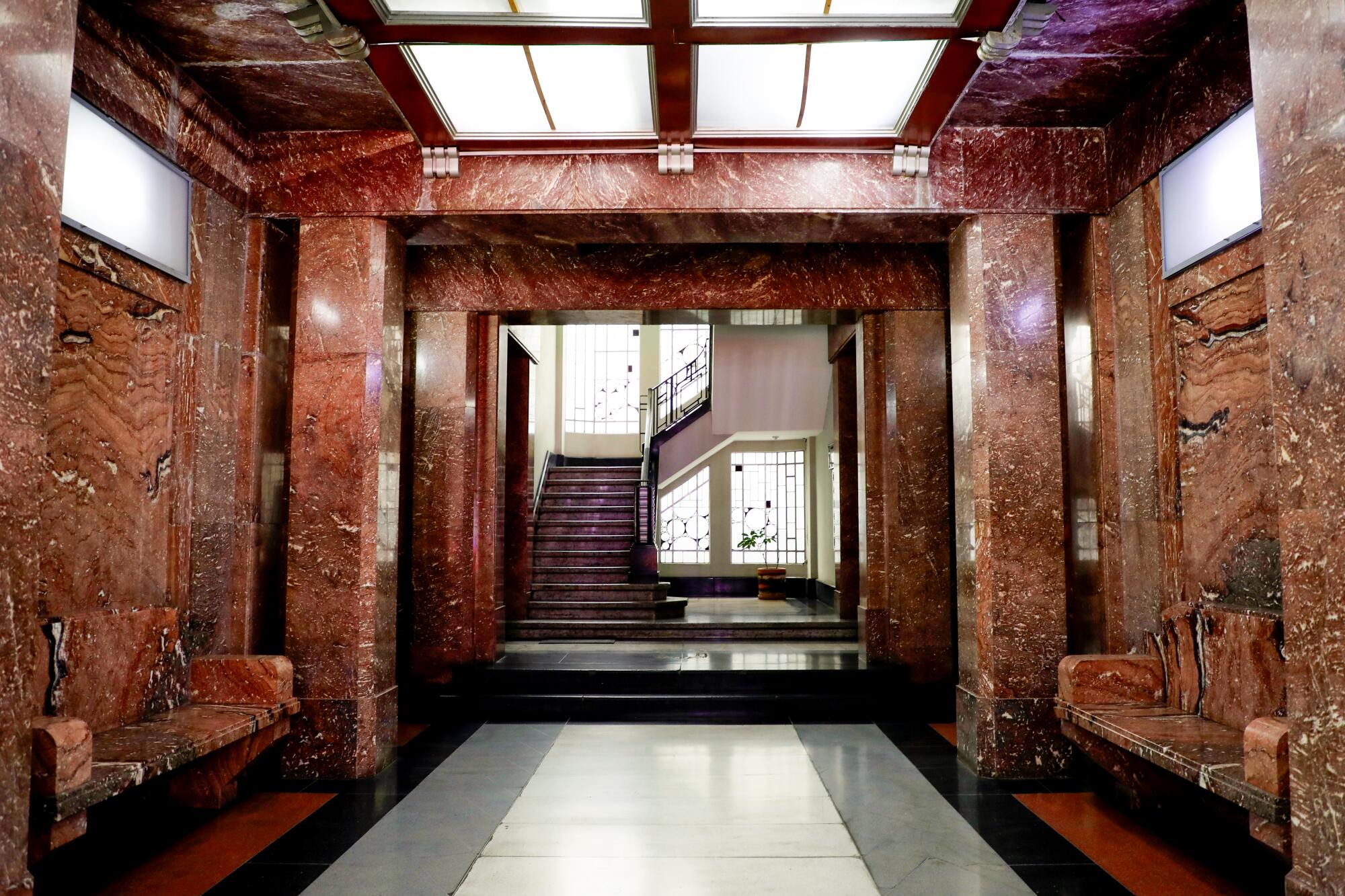
Inside the marble lobby of the Edificio Victoria. The identity of its architect is inconclusive, according to published research.
(Eunice Adorno / For The Times)
Besides its primary landmarks, most of downtown in the 2000s was still, unbelievably, “off the beaten path.” The mayor at the time — current President Andrés Manuel López Obrador — wanted to spruce up the Colonial core of downtown and draw tourists again. The old city had languished in neglect for decades, precipitated by the catastrophe of the 1985 earthquake.
In No. 106 at Edificio Victoria, I settled in and began writing, facing the window overlooking the street. All the noises melded into one continuous static hum.
I learned that many of Edificio Victoria‘s tenants were old-timers or families. Others, like me, were younger, creative types, carving out careers. Across the inner well of the building, I heard English one evening and made friends with a mixed group of Americans and Mexicans who lived in the area. We struggled like a band of drifters, cobbling together our incomes and being resourceful and communal to keep the party going. I translated, taught English, wrote a blog. We held a Day of the Dead party in the Victoria penthouse, which most of the time sat unused, a bit creepily, to honor a lost friend and dance in our skeletons.
James Young, a writer, editor and actor, moved to downtown Mexico City in 2000 and still lives in the same old apartment near a plaza. We were neighbors and friends. “When I think back to the old Centro, in general, it was … sketchy, man,” he told me recently as we shared a laugh. “I liked it. It was more punk rock.”
The Georgia native said, “Things are better now,” adding that he finds it gratifying to see that many old-school restaurants and stands remain prized neighborhood institutions.
“I like that there’s old gems that still stick around,” he said. “I enjoy living in this part of the city that’s become a focus of the culinary interest of visitors, people who love food.”
To the Aztecs, the barrio was known as Moyotlan, the quadrant southwest of the Templo Mayor, with a temple to the flayed god Xipe Totec. After conquest and over time, the neighborhood became the Barrio de San Juan, in reference to its original markets. Two food markets remain: the Mercado Ernesto Pugibet, now known as the gourmet market for its stalls selling European meats and cheeses and unusual wild game; and the Mercado San Juan Arcos de Belén, its more working-class sibling, full of traditional fondas for a comida corrida lunch.
To this day, the neighborhood — Moyotlan, then San Juan, then Colonia Centro — is a location of commerce, with interlocking restaurants, diners, stores, cantinas, churches, arcades, offices, wholesalers, gyms, bakeries, bars, museums and chicken vendors — an entire street of them.
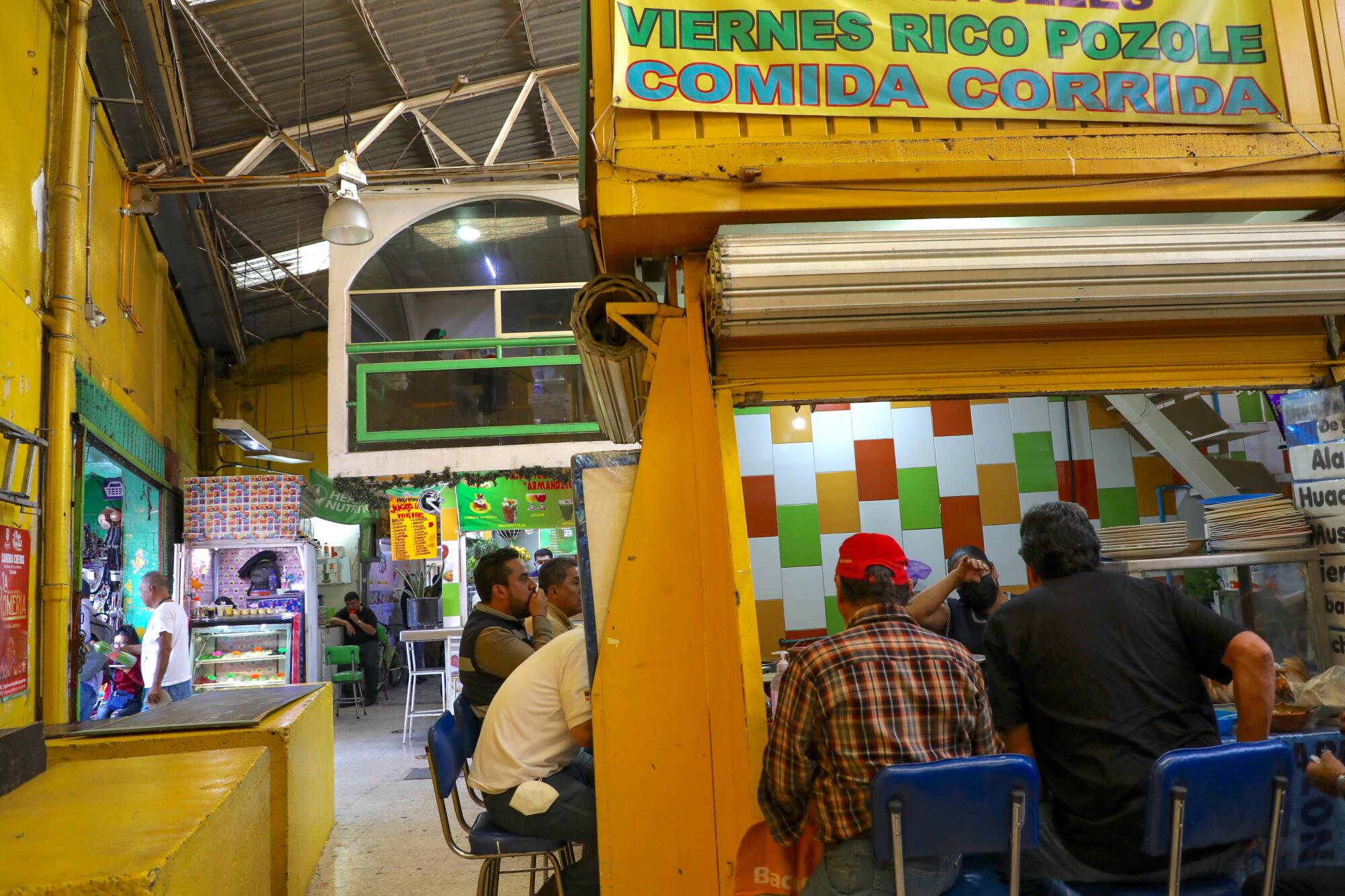
The Mercado San Juan Arcos de Belén does brisk business in comida corrida, what the crowds eat for lunch.
(Eunice Adorno / For The Times)
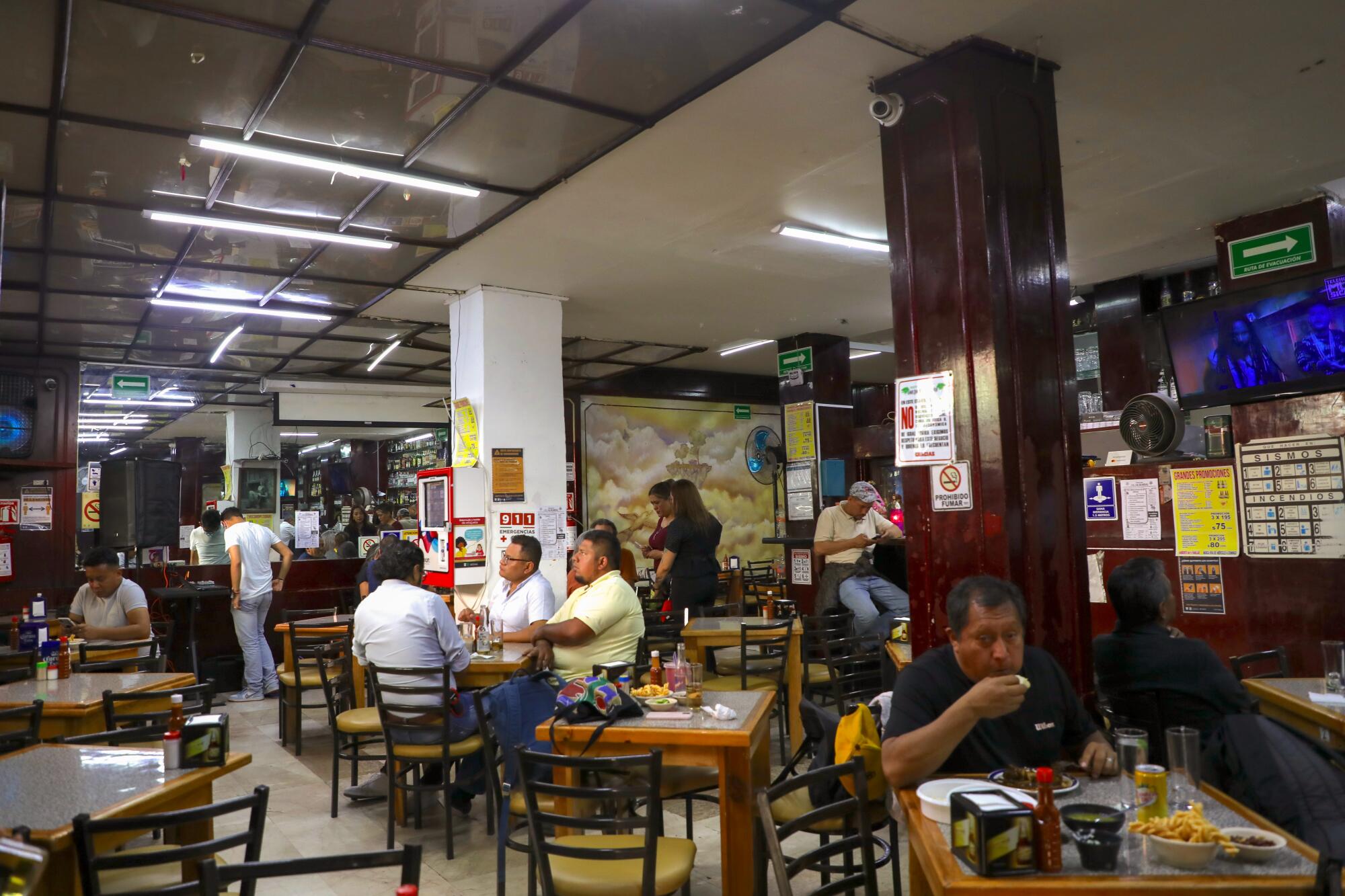
The cantina Las Jacarandas on Calle López offers a traditional botana: a suite of house-made small dishes served as a courtesy — as long as you keep drinking, and tip extravagantly.
(Eunice Adorno / For The Times)
A variety of architectural styles played off one another too, from Colonial to neo-Baroque to neo-Gothic to Art Deco to Streamline Moderne to postwar modern. Around Calle López, there were ’hoods within ’hoods. I became attuned to its rhythms. Boarders observed the street from run-down buildings with laundry hanging in windows. Twentysomething hustler types ducked into unlicensed speakeasies, hidden inside first-floor apartments.
Urbanized Mexican Indigenous people, young and old, native to the valley or immigrants from Oaxaca and Puebla, lived and worked as our neighbors. I observed how they kept their worlds distinct, in occupied squats with banners for esoteric revolutionary movements, and with large Sunday socials in hidden halls for the youth, who could be heard chattering and giggling into cellphones using only Indigenous languages.
Calle López, I discovered, also had a cryptic Spanish vibe — and I don’t mean back to the conquest era. It was actually the result of more recent history not often taught in the United States: the influx of Spaniards who fled after their homeland’s civil war ended in 1939. Many exiled socialists and anti-fascist republicans settled in the Centro, specifically around Calle López. Other groups also began migrating here in this period — Armenians, Chinese, Jews and more — all contributing to the city’s eternally cosmopolitan sense of self.
Centro also has pockets of Lebanese life, especially in its southeastern quadrant, closer to the market and barrio of Merced, and the shrine of St. Charbel, the unofficial patron of the Mexican Lebanese. And, of course, Colonia Centro is home to the delightfully retro Barrio Chino, limited more or less to a single pedestrian block of Dolores Street and a bunch of old-school Chinese chop houses that are regrettably not known for having good food. A century ago, Mexico City’s Chinatown was home to many opium dens. The Beats hung out here too.

Laundry hangs in windows over Calle López.
(Eunice Adorno / For The Times)
During the pandemic, Mexico City’s central location (corresponding with Central time), accessibility to major U.S. cities by plane, agreeable climate and affordability of a first-rate lifestyle versus in the United States made it an ideal destination for hordes of suddenly liberated remote workers.
The consequences have been real.
Housing expenses are rising in Mexico overall, going up almost 10% in the third trimester of 2022 alone, according to the country’s official housing price index. The financial newspaper El Financiero reported that in 2022, more than 40% of home sales in Mexico City were to foreign buyers. Similarly, Airbnb listings grew by 38% between 2019 and 2022.
Tamara Velasquez, a Mexico City native and doctoral student at Rutgers University who is researching gentrification in her hometown, said the pandemic accelerated a process that was well underway.
“What we are seeing now is essentially the culmination of a 20-year effort by the local government to gentrify the central parts of [Mexico City], importing ideas from U.S.-based gentrification proponents such as Richard Florida and others,” Velasquez said. “The city moved to position itself as a global brand, hiring marketing consultants to make the city ‘cool’ to foreigners.”
Anti-gringo graffiti and banners have cropped up here and there in the neighborhoods most affected: the traveler-friendly areas of Condesa and Roma.
Mario Ballesteros, a design curator, writer and Mexico City native, was one of the first people to welcome me when I moved here. We’d troll around the Centro cantinas with local punk writer-artist friends, drinking boundlessly.
The phenomenon of foreigners crowding into certain neighborhoods is not the same as the gentrification effect in places like, say, central Los Angeles, Oakland or Brooklyn, he said.
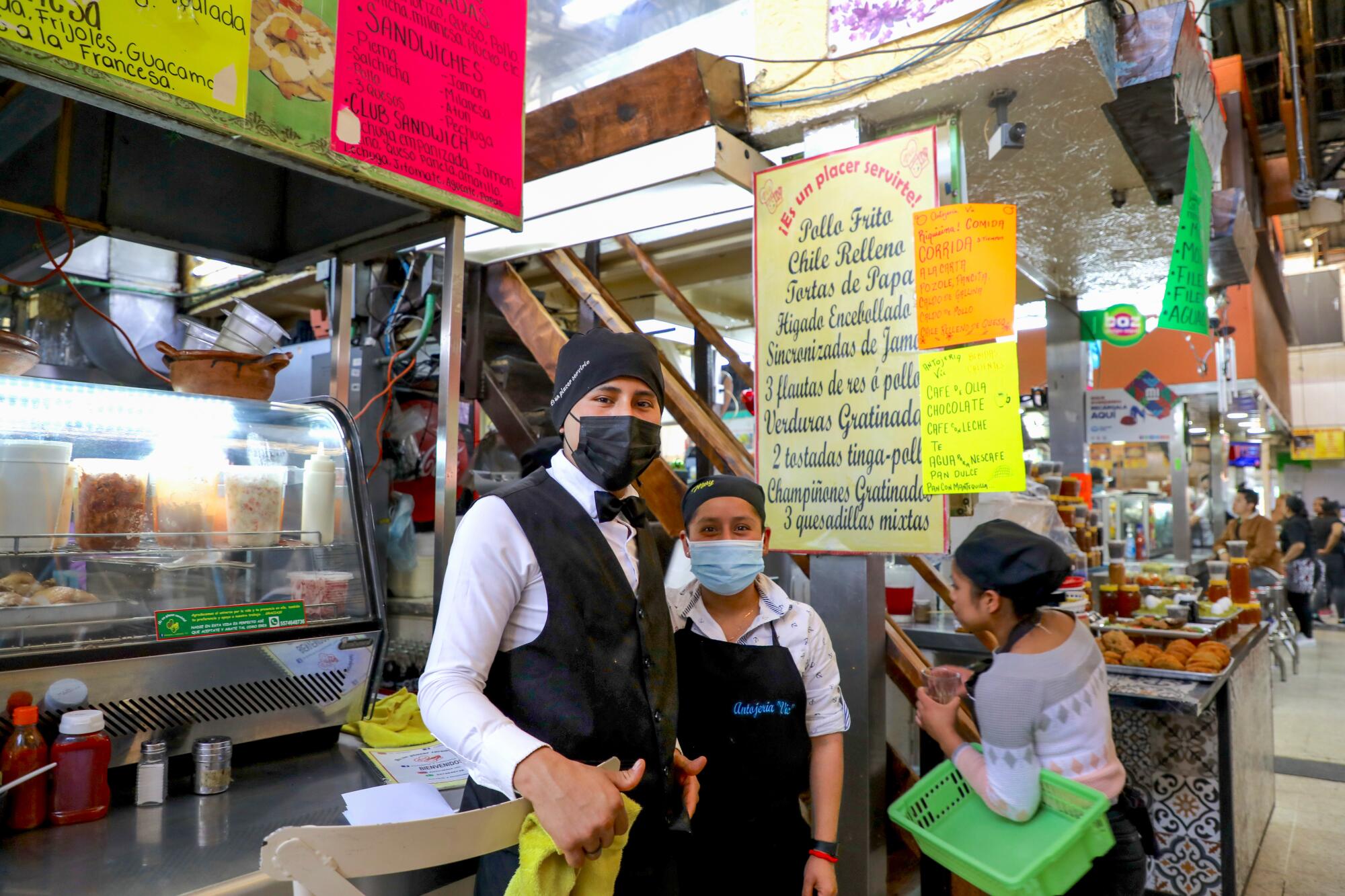
After conquest and over time, this central neighborhood became the Barrio de San Juan, in reference to its original markets: One of them is the Mercado San Juan Arcos de Belén.
(Eunice Adorno / For The Times)
“The expats are not pushing folks out of their buildings; they’re pricing out whitexicans [an Internet pejorative for privileged Mexicans] from their ‘cheap’ apartments and restaurants and bars,” Ballesteros said.
Elizabeth Flores, another former neighbor of mine in Colonia Centro, is a Mexico City native, author and culinary guide. She agreed the city is basically too big to gentrify in the conventional sense and that the Centro in particular is immune to its winds. “It’s a place of constant change, and at the same time, where all the culinary traditions of Mexico are kind of born,” Flores said. “Even if some parts of it are experiencing gentrification, the old barrio traditions stay the same.”
Nonetheless, a narrative persists. Mexico City may be showing the first signs of being too cool for its own good, with some cases of pushback.
The residents of the Edificio Trevi, directly facing Alameda Central park, spent years organizing to fight the flipping of the building. They advanced their cause for fair housing until the pandemic hit. The building now is boarded up and awaiting some kind of renewal as a foreigner-friendly housing hub.
Then came word about the Edificio Victoria changing. This year, residents, many of them long-term, received notices that their rental contracts would not be renewed. The family that had owned the building for decades finally sold it, reportedly to a group that would be turning it into an Airbnb, which has become something of a byword in Mexico for “gentrification.”
Tenants and other neighbors sounded the alarm. Could the housing issues that have popped up in Condesa and Roma now be spilling toward the Centro?
On a recent Thursday, I found myself at López and Victoria streets again, staring up at the Edificio Victoria. I approached the door and noticed a figure waiting in the lobby, so I asked to be let in.
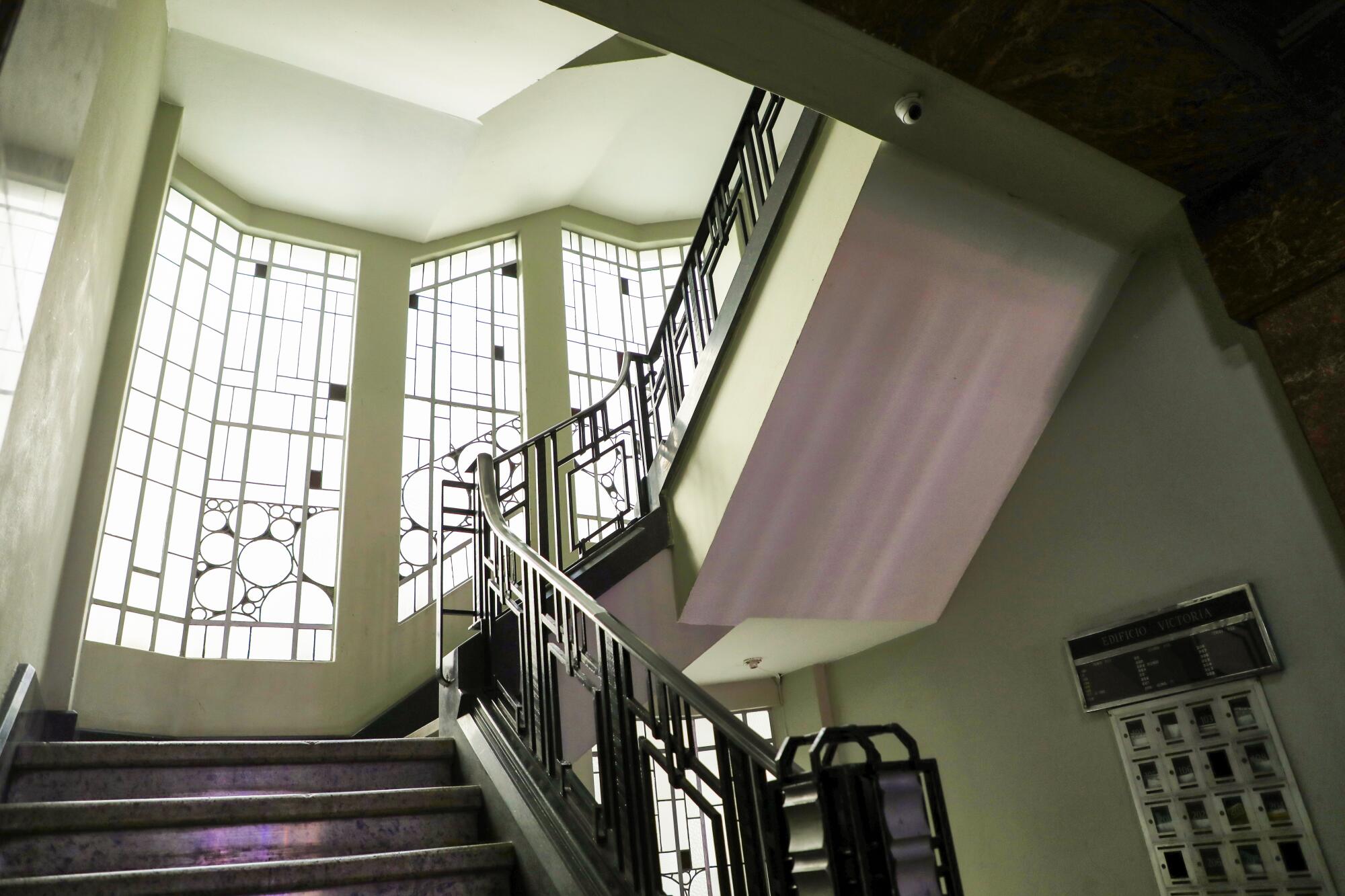
The writer and his neighbors cobbled together their incomes and resources to keep the party going inside the Edificio Victoria.
(Eunice Adorno / For The Times)
Marcia Martínez, an artist and designer, moved into the building eight years ago. She was in the process of turning in her keys, the final step in saying goodbye to the building.
“It is very sad, to be honest. In a while, it won’t be called Calle López, it will be Lo-PEZ,” she said, mimicking an exaggerated American Spanish accent. “The joke is it’s almost like you need a visa to enter Roma.”
Martínez was clearly indulging in the bitterness that accompanies displacement. She said she had figured out another place to live, but others in the building weren’t so lucky.
Repeated attempts to seek comment from the building’s new owners were unsuccessful. That day, I walked up the central staircase of the building, with glazed windows facing a lovely interior courtyard adorned with a dormant fountain of green and blue ceramic tiles. I admit the thought crossed my mind: If the Edificio Victoria were to turn into a short-term rental building, who wouldn’t want to stay here?
I returned to Los Angeles in 2016, but by then, Mexico City had mutated me in ways I am still trying to understand. My accent in Spanish, for example, changed from Tijuanense to Mexico City cosmopolitan, and I can’t really bring it back, making my San Diego and Tijuana family and friends laugh at how “chilango” I sound.
I’m aware of the ironies. My generation’s parents were leaving Mexico, not moving there as adults. My mobility in a way reflects the privileges immigrant Mexicans like my parents have aquired in the United States. Their children like me were going to the University of California and California State University, instead of working in the fields or the corridors of big hotels. If U.S.-born, we could “return” to Mexico, a place that we often hardly knew, as sort of reverse expatriates, unburdened.
I try to stay calm about all the attention Mexico City is getting.
Filmmaker Jazmín García, an L.A. native of Mexican and Guatemalan descent, had been splitting time between Los Angeles and Mexico City for years but moved down permanently a year ago to be closer to family.
“I love that this is the city of spontaneity,” García said over a recent meal at one of her family’s favorite restaurants, a Lebanese jewel in a Colonial building called Al Andalus. “You can walk anywhere. You can bike anywhere. There’s music everywhere.”
But she’s also noticed the onslaught of nonheritage American expats who remain concentrated in a few social or geographic bubbles and who come with a sense of entitlement that she described as off-putting.
“People should come to Mexico and learn about it, but you should have better reasons than cheap rent and good parties to want to move here,” García said. “It’s a beautiful, wonderful place to visit and learn from. But find ways to contribute.”
I have been back here four times in the last year, including three visits since January. I stayed downtown and ate along Calle López with a dedicated fervor.
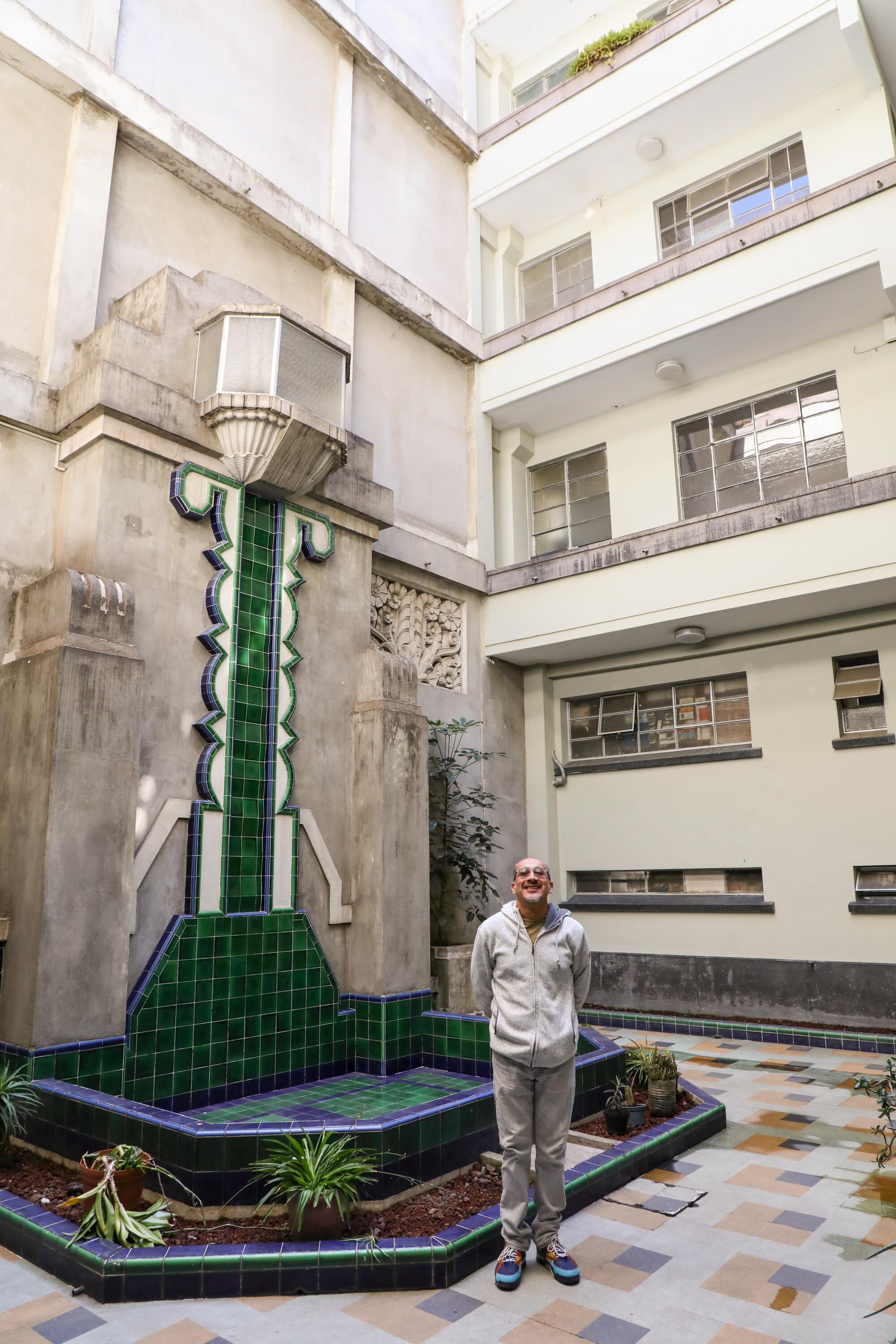
Daniel Hernadez visits his former home, Edificio Victoria, in the historic center of Mexico City.
(Eunice Adorno / For The Times)
As I pondered Edificio Victoria succumbing to a polished renewal, everything else, I discovered, felt more or less the same. The beans from Veracruz and Chiapas are still roasting in the open air at the Villarías coffee company. Tacos are still 15 pesos each at the Yucatán-style cochinita shop El Taco de Oro. Most stores haven’t changed. A small, hunched-over woman with leathery skin still stands on a corner that is used customarily as a stop for buses departing for the far-off suburbs, and she still calls out with a carnival barker’s affectation, “Hop on, hop on, hop on …”
As much as Centro has changed, for me, it is still itself.
I walked into a rollicking dive bar known as a pulquería, where only pulque is served. And the young dude who always sat in the corner, a mute, as I would later learn, sort of nodded to me, regarding my presence again among the tattooed punks and college students and seniors. This was Las Duelistas, or The Dueling Ladies. I probably spent as much time here for a period as I did in my apartment. The usual barkeep, who somehow vaguely resembled Amy Winehouse, also nodded at me, not like, ‘Where have you been?’ but more like, ‘What do you want to drink?’
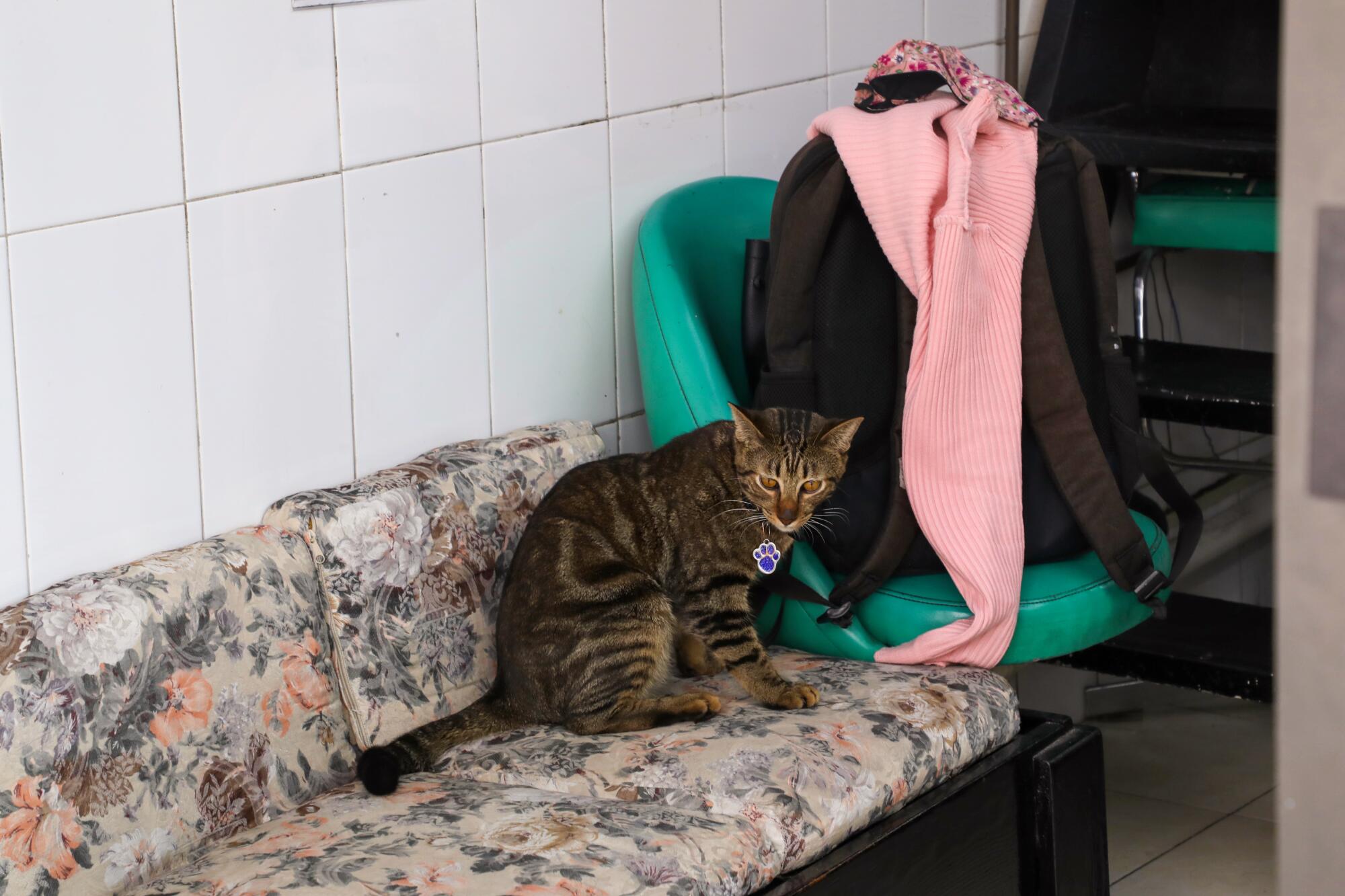
A cat in a beauty salon on Calle López
(Eunice Adorno / For The Times)



